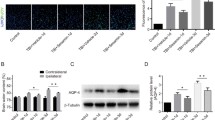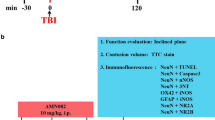Abstract
Aloin is a small-molecule drug well known for its protective actions in various models of damage. Traumatic brain injury (TBI)-induced cerebral edema from secondary damage caused by disruption of the blood–brain barrier (BBB) often leads to an adverse prognosis. Since the role of aloin in maintaining the integrity of the BBB after TBI remains unclear, we explored the protective effects of aloin on the BBB using in vivo and in vitro TBI models. Adult male C57BL/6 mice underwent controlled cortical impact injury, and mouse brain capillary endothelial bEnd.3 cells underwent biaxial stretch injury, then both received aloin treatment. In the animal experiments, we found 20 mg/kg aloin to be the optimum concentration to decrease cerebral edema, decrease disruption of the BBB, and improve neurobehavioral performance after cortical impact injury. In the cellular studies, the optimum concentration of 40 μg/mL aloin reduced apoptosis and reversed the loss of tight junctions by reducing the reactive oxygen species levels and changes in mitochondrial membrane potential after stretch injury. The mechanisms may be that aloin downregulates the phosphorylation of p38 mitogen-activated protein kinase, the activation of p65 nuclear factor-kappa B, and the ratios of B cell lymphoma (Bcl)-2-associated X protein/Bcl-2 and cleaved caspase-3/caspase-3. We conclude that aloin exhibits these protective effects on the BBB after TBI through its anti-oxidative stress and anti-apoptotic properties in mouse brain capillary endothelial cells. Aloin may thus be a promising therapeutic drug for TBI.









Similar content being viewed by others
References
Needham EJ, Helmy A, Zanier ER, Jones JL, Coles AJ, Menon DK. The immunological response to traumatic brain injury. J Neuroimmunol 2019, 332: 112–125.
Yang DX, Jing Y, Liu YL, Xu ZM, Yuan F, Wang ML, et al. Inhibition of transient receptor potential vanilloid 1 attenuates blood–brain barrier disruption after traumatic brain injury in mice. J Neurotrauma 2019, 36: 1279–1290.
Jiang JY, Gao GY, Feng JF, Mao Q, Chen LG, Yang XF, et al. Traumatic brain injury in China. Lancet Neurol 2019, 18: 286–295.
Zhang L, Wang H, Zhou X, Mao L, Ding K, Hu Z. Role of mitochondrial calcium uniporter-mediated Ca(2+) and iron accumulation in traumatic brain injury. J Cell Mol Med 2019, 23: 2995–3009.
Liu YL, Yuan F, Yang DX, Xu ZM, Jing Y, Yang GY, et al. Adjudin attenuates cerebral edema and improves neurological function in mice with experimental traumatic brain injury. J Neurotrauma 2018, 35: 2850–2860.
Xu ZM, Yuan F, Liu YL, Ding J, Tian HL. Glibenclamide attenuates blood–brain barrier disruption in adult mice after traumatic brain injury. J Neurotrauma 2017, 34: 925–933.
Michinaga S, Koyama Y. Dual roles of astrocyte-derived factors in regulation of blood–brain barrier function after brain damage. Int J Mol Sci 2019, 20: 571.
Liu YL, Xu ZM, Yang GY, Yang DX, Ding J, Chen H, et al. Sesamin alleviates blood–brain barrier disruption in mice with experimental traumatic brain injury. Acta Pharmacol Sin 2017, 38: 1445–1455.
Luissint AC, Artus C, Glacial F, Ganeshamoorthy K, Couraud PO. Tight junctions at the blood brain barrier: physiological architecture and disease-associated dysregulation. Fluids Barriers CNS 2012, 9: 23.
Hu HM, Li B, Wang XD, Guo YS, Hui H, Zhang HP, et al. Fluoxetine is neuroprotective in early brain injury via its anti-inflammatory and anti-apoptotic effects in a rat experimental subarachnoid hemorrhage model. Neurosci Bull 2018, 34: 951–962.
Lee W, Yang S, Lee C, Park EK, Kim KM, Ku SK, et al. Aloin reduces inflammatory gene iNOS via inhibition activity and p-STAT-1 and NF-κB. Food Chem Toxicol 2019, 126: 67–71.
Zhong J, Wang F, Wang Z, Shen C, Zheng Y, Ma F, et al. Aloin attenuates cognitive impairment and inflammation induced by d-galactose via down-regulating ERK, p38 and NF-κB signaling pathway. Int Immunopharmacol 2019, 72: 48–54.
Chang R, Zhou R, Qi X, Wang J, Wu F, Yang W, et al. Protective effects of aloin on oxygen and glucose deprivation-induced injury in PC12 cells. Brain Res Bull 2016, 121: 75–83.
Pan Q, Pan H, Lou H, Xu Y, Tian L. Inhibition of the angiogenesis and growth of Aloin in human colorectal cancer in vitro and in vivo. Cancer Cell Int 2013, 13: 69.
Silva MA, Trevisan G, Hoffmeister C, Rossato MF, Boligon AA, Walker CIB, et al. Anti-inflammatory and antioxidant effects of Aloe saponaria Haw in a model of UVB-induced paw sunburn in rats. J Photochem Photobiol B 2014, 133: 47–54.
Yuan F, Xu ZM, Lu LY, Nie H, Ding J, Ying WH, et al. SIRT2 inhibition exacerbates neuroinflammation and blood–brain barrier disruption in experimental traumatic brain injury by enhancing NF-κB p65 acetylation and activation. J Neurochem 2016, 136: 581–593.
Sarkar C, Zhao Z, Aungst S, Sabirzhanov B, Faden AI, Lipinski MM. Impaired autophagy flux is associated with neuronal cell death after traumatic brain injury. Autophagy 2014, 10: 2208–2222.
Tang G, Liu Y, Zhang Z, Lu Y, Wang Y, Huang J, et al. Mesenchymal stem cells maintain blood–brain barrier integrity by inhibiting aquaporin-4 upregulation after cerebral ischemia. Stem Cells 2014, 32: 3150–3162.
Ni H, Yang S, Siaw-Debrah F, Hu J, Wu K, He Z, et al. Exosomes derived from bone mesenchymal stem cells ameliorate early inflammatory responses following traumatic brain injury. Front Neurosci 2019, 13: 14.
Vorhees CV, Williams MT. Morris water maze: procedures for assessing spatial and related forms of learning and memory. Nat Protoc 2006, 1: 848–858.
Jing Y, Zhang L, Xu ZM, Chen H, Ju SM, Ding J, et al. Phosphatase actin regulator-1 (PHACTR-1) knockdown suppresses cell proliferation and migration and promotes cell apoptosis in the bEnd.3 mouse brain capillary endothelial cell line. Med Sci Monit 2019, 25: 1291–1300.
Xu Z, Liu Y, Yang D, Yuan F, Ding J, Chen H, et al. Sesamin protects SH-SY5Y cells against mechanical stretch injury and promoting cell survival. BMC Neurosci 2017, 18: 57.
Ahmed SM, Rzigalinski BA, Willoughby KA, Sitterding HA, Ellis EF. Stretch-induced injury alters mitochondrial membrane potential and cellular ATP in cultured astrocytes and neurons. J Neurochem 2000, 74: 1951–1960.
Fang J, Zhu Y, Wang H, Cao B, Fei M, Niu W, et al. Baicalin protects mice brain from apoptosis in traumatic brain injury model through activation of autophagy. Front Neurosci 2018, 12: 1006.
Bhowmick S, D’Mello V, Caruso D, Wallerstein A, Abdul-Muneer PM. Impairment of pericyte-endothelium crosstalk leads to blood–brain barrier dysfunction following traumatic brain injury. Exp Neurol 2019, 317: 260–270.
Wang ZF, Gao C, Chen W, Gao Y, Wang HC, Meng Y, et al. Salubrinal offers neuroprotection through suppressing endoplasmic reticulum stress, autophagy and apoptosis in a mouse traumatic brain injury model. Neurobiol Learn Mem 2019, 161: 12–25.
Cernak I, Wing ID, Davidsson J, Plantman S. A novel mouse model of penetrating brain injury. Front Neurol 2014, 5: 209.
Sajja VSSS, Jablonska A, Haughey N, Bulte JWM, Stevens RD, Long JB, et al. Sphingolipids and microRNA changes in blood following blast traumatic brain injury: an exploratory study. J Neurotrauma 2018, 35: 353–361.
Washington PM, Forcelli PA, Wilkins T, Zapple DN, Parsadanian M, Burns MP. The effect of injury severity on behavior: a phenotypic study of cognitive and emotional deficits after mild, moderate, and severe controlled cortical impact injury in mice. J Neurotrauma 2012, 29: 2283–2296.
Huang SX, Qiu G, Cheng FR, Pei Z, Yang Z, Deng XH, et al. Berberine protects secondary injury in mice with traumatic brain injury through anti-oxidative and anti-inflammatory modulation. Neurochem Res 2018, 43: 1814–1825.
Wang D, Xu X, Wu YG, Lyu L, Zhou ZW, Zhang JN. Dexmedetomidine attenuates traumatic brain injury: action pathway and mechanisms. Neural Regen Res 2018, 13: 819–826.
Hao FL, Han XF, Wang XL, Zhao ZR, Guo AH, Lu XJ, et al. The neurovascular protective effect of alogliptin in murine MCAO model and brain endothelial cells. Biomed Pharmacother 2019, 109: 181–187.
Rehman SU, Ahmad A, Yoon GH, Khan M, Abid MN, Kim MO. Inhibition of c-Jun N-terminal kinase protects against brain damage and improves learning and memory after traumatic brain injury in adult mice. Cereb Cortex 2018, 28: 2854–2872.
Gao C, Qian Y, Huang J, Wang D, Su W, Wang P, et al. A three-day consecutive fingolimod administration improves neurological functions and modulates multiple immune responses of CCI mice. Mol Neurobiol 2017, 54: 8348–8360.
Xie BS, Wang YQ, Lin Y, Mao Q, Feng JF, Gao GY, et al. Inhibition of ferroptosis attenuates tissue damage and improves long-term outcomes after traumatic brain injury in mice. CNS Neurosci Ther 2019, 25: 465–475.
Zhou Q, Wang YW, Ni PF, Chen YN, Dong HQ, Qian YN. Effect of tryptase on mouse brain microvascular endothelial cells via protease-activated receptor 2. J Neuroinflammation 2018, 15: 248.
Abdul-Muneer PM, Chandra N, Haorah J. Interactions of oxidative stress and neurovascular inflammation in the pathogenesis of traumatic brain injury. Mol Neurobiol 2015, 51: 966–979.
Yuan F, Liu R, Hu M, Rong X, Bai L, Xu L, et al. JAX2, an ethanol extract of Hyssopus cuspidatus Boriss, can prevent bronchial asthma by inhibiting MAPK/NF-κB inflammatory signaling. Phytomedicine 2019, 57: 305–314.
Tao L, Li D, Liu H, Jiang F, Xu Y, Cao Y, et al. Neuroprotective effects of metformin on traumatic brain injury in rats associated with NF-κB and MAPK signaling pathway. Brain Res Bull 2018, 140: 154–161.
Zhang L, Zhang L, Liu H, Jiang F, Wang H, Li D, et al. Inhibition of Epac2 attenuates neural cell apoptosis and improves neurological deficits in a rat model of traumatic brain injury. Front Neurosci 2018, 12: 263.
Wang X, Lan YL, Xing JS, Lan XQ, Wang LT, Zhang B. Alantolactone plays neuroprotective roles in traumatic brain injury in rats via anti-inflammatory, anti-oxidative and anti-apoptosis pathways. Am J Transl Res 2018, 10: 368–380.
Azarashvili T, Stricker R, Reiser G. The mitochondria permeability transition pore complex in the brain with interacting proteins—promising targets for protection in neurodegenerative diseases. Biol Chem 2010, 391: 619–629.
Chae IH, Park KW, Kim HS, Oh BH. Nitric oxide-induced apoptosis is mediated by Bax/Bcl-2 gene expression, transition of cytochrome c, and activation of caspase-3 in rat vascular smooth muscle cells. Clin Chim Acta 2004, 341: 83–91.
Yang J, Liu XS, Bhalla K, Kim CN, Ibrado AM, Cai J, et al. Prevention of apoptosis by Bcl-2: Release of cytochrome c from mitochondria blocked. Science 1997, 275: 5303.
Knoblach SM, Nikolaeva M, Huang X, Fan L, Krajewski S, Reed JC, et al. Multiple caspases are activated after traumatic brain injury: evidence for involvement in functional outcome. J Neurotrauma 2002, 19: 1155–1170.
Cheng G, Kong RH, Zhang LM, Zhang JN. Mitochondria in traumatic brain injury and mitochondrial-targeted multipotential therapeutic strategies. Br J Pharmacol 2012, 167: 699–719.
Wang X, Li S, Ma J, Wang C, Chen A, Xin Z, et al. Effect of gastrodin on early brain injury and neurological outcome after subarachnoid hemorrhage in rats. Neurosci Bull 2019, 35: 461–470.
Glober NK, Sprague S, Ahmad S, Mayfield KG, Fletcher LM, Digicaylioglu MH, et al. Acetazolamide treatment prevents redistribution of astrocyte aquaporin 4 after murine traumatic brain injury. Neurosci J 2019, 2019: 1–12.
Acknowledgements
We thank Prof. Guo-yuan Yang (School of Biomedical Engineering and Med-X Research Institute of Shanghai Jiao Tong University, Shanghai, China) for guidance in experiments. This work was supported by the National Natural Science Foundation of China (81671207, 81701895, and 81501048) and the Shanghai Jiao Tong University Medicine-Engineering Research Fund (YG2016QN20).
Author information
Authors and Affiliations
Corresponding authors
Ethics declarations
Conflict of interest
The authors declare no competing interests.
Rights and permissions
About this article
Cite this article
Jing, Y., Yang, DX., Wang, W. et al. Aloin Protects Against Blood–Brain Barrier Damage After Traumatic Brain Injury in Mice. Neurosci. Bull. 36, 625–638 (2020). https://doi.org/10.1007/s12264-020-00471-0
Received:
Accepted:
Published:
Issue Date:
DOI: https://doi.org/10.1007/s12264-020-00471-0




